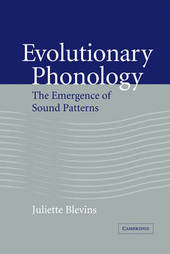
|
Evolutionary Phonology: The Emergence of Sound Patterns
Hardback
Main Details
| Title |
Evolutionary Phonology: The Emergence of Sound Patterns
|
| Authors and Contributors |
By (author) Juliette Blevins
|
| Physical Properties |
| Format:Hardback | | Pages:388 | | Dimensions(mm): Height 236,Width 160 |
|
| Category/Genre | Phonetics and phonology |
|---|
| ISBN/Barcode |
9780521804288
|
| Classifications | Dewey:414 |
|---|
| Audience | | Professional & Vocational | |
|---|
|
Publishing Details |
| Publisher |
Cambridge University Press
|
| Imprint |
Cambridge University Press
|
| Publication Date |
22 July 2004 |
| Publication Country |
United Kingdom
|
Description
Evolutionary Phonology is a new theory of sound patterns which synthesizes results in historical linguistics, phonetics, and phonological theory. In this groundbreaking book, Juliette Blevins explores the nature of sounds patterns and sound change in human language over the past 7000-8000 years, the time depth for which the comparative method is reasonably reliable. This book presents a new approach to the problem of how genetically unrelated languages, from families as far apart as Native American, Australian Aboriginal, Austronesian, and Indo-European, can often show similar sound patterns, and also tackles the converse problem of why there are notable exceptions to most of the patterns that are often regarded as universal tendencies or constraints. It argues that in both cases, a formal model of sound change that integrates phonetic variation and patterns of misperception can account for attested sound systems without reference to markedness or naturalness within the synchronic grammar.
Author Biography
Juliette Blevins was formerly Visiting Professor at the Department of Linguistics, University of California, Berkeley, and joined the Department of Linguistics at the Max Planck Institute for Evolutionary Anthropology, Leipzig, in Fall 2004.
Reviews'The book contains everything that makes a linguistics book fascinating to read: an overview of the field, a provocative theory for explaining phonological facts, and numerous contemporary and historical examples from a wide sample of languages to support the new theory ... As a whole, I think the book makes an interesting contribution to the field of phonology. The theory presented proposes that much of the complexity of human sound systems is due to historical processes that are set in motion by different kinds of misperception, while the actual learning and representations in the mind/brain are relatively simple and general ... Blevins' theory does not propose strict formal rules and algorithms to process and learn sound system, but rather a number of mechanisms, heuristics and ways of looking at linguistic phenomena that can be adapted to particular instances ... I consider this to be a practical perspective ... all in all, I found this book easier to read and less formal than most books on phonological theory ... this book is well worth reading for a new perspective on phonology that conforms to the trend towards more data-driven models of language.' Journal of Linguistics
|